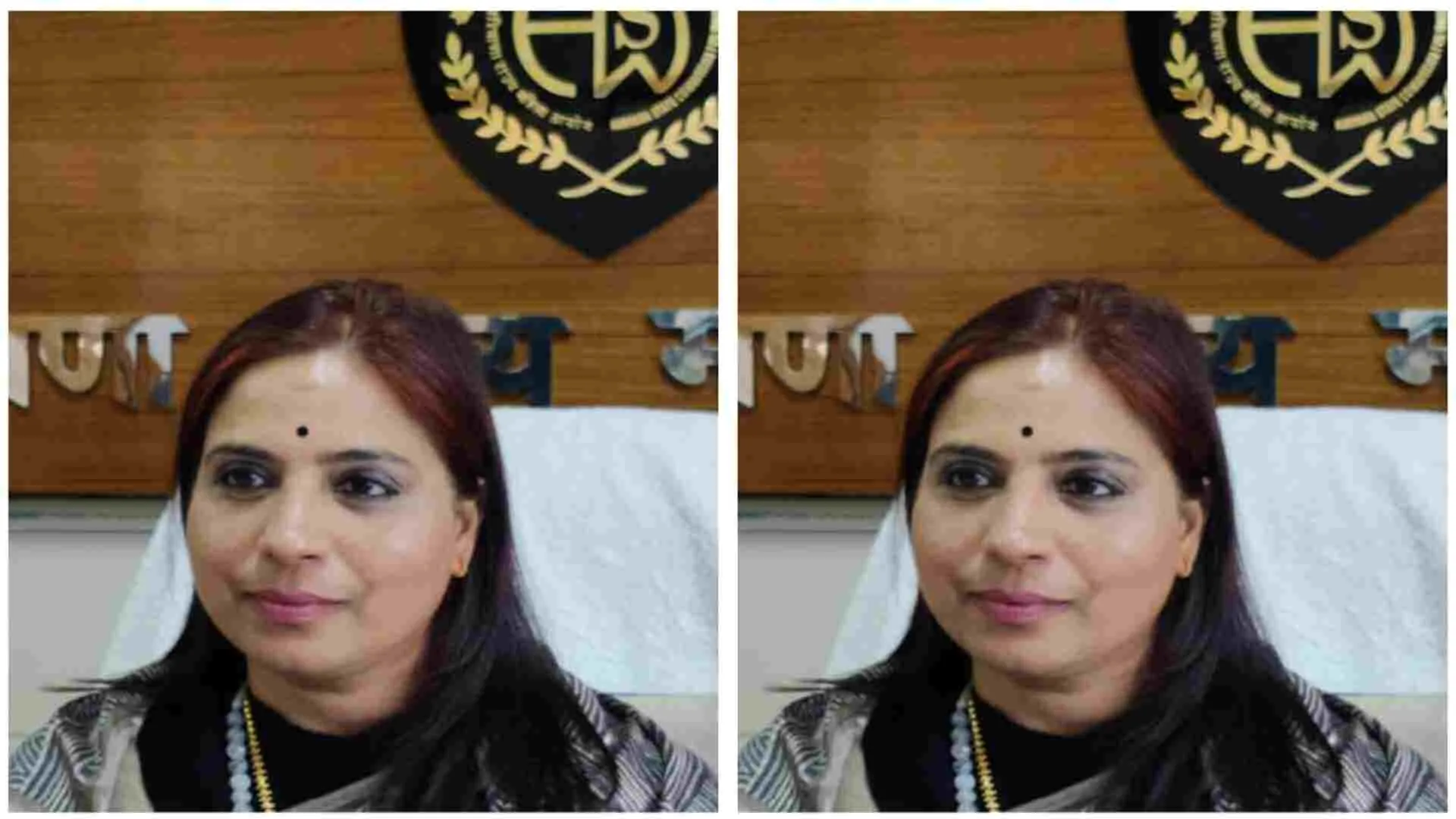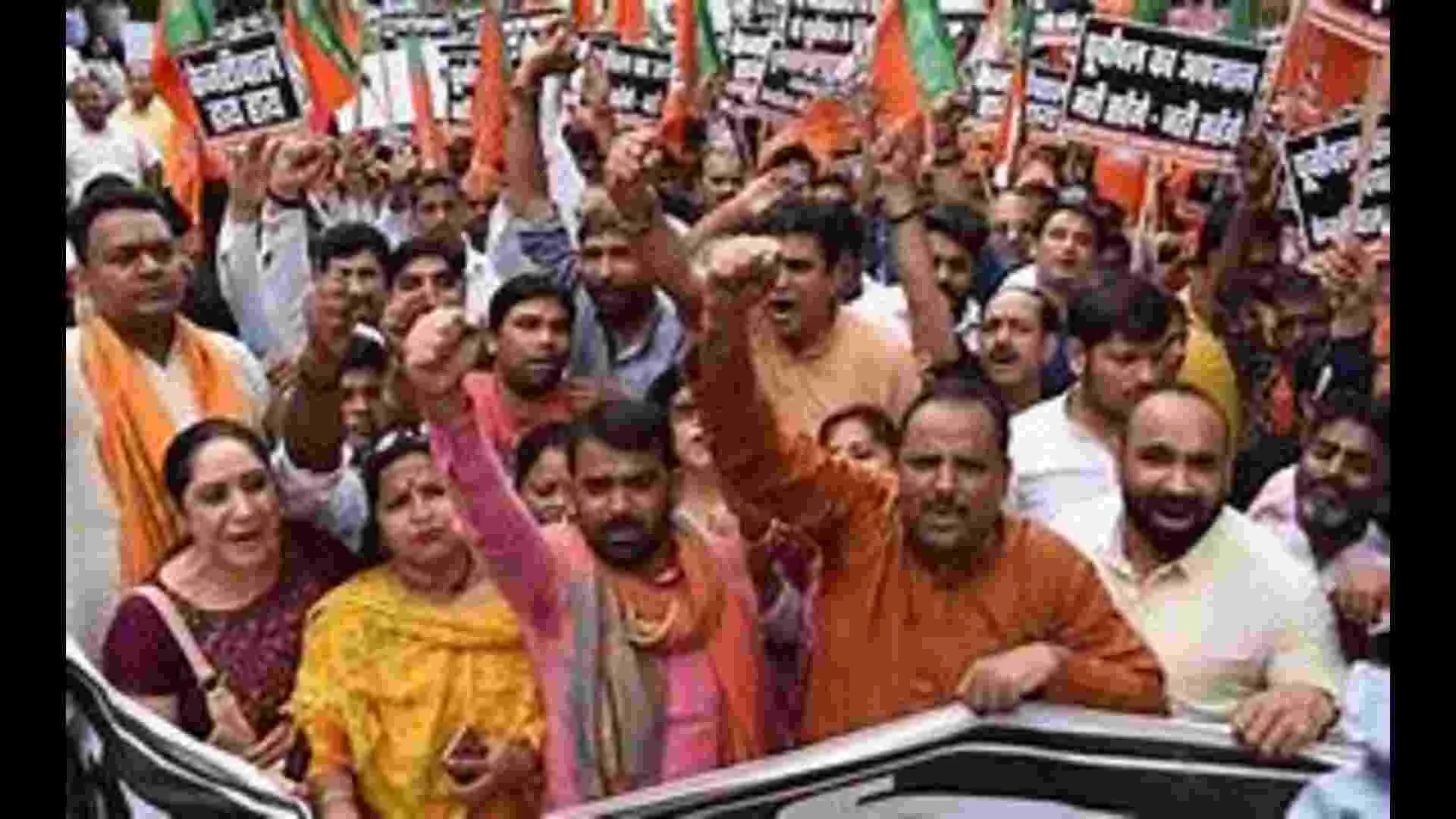Andhra Pradesh has earned for itself the sobriquet of “Annapurna” or Rice Bowl of the country, which symbolizes the entrepreneurial spirit that the hard working citizens of the state are known for. At present, Andhra’s GSDP is projected above Rs. 13.38 lakh crore and the state revenue comprising own tax and non tax revenue stand at Rs. 76.55 thousand crore and its share in Central taxes at Rs. 32.24 thousands crore along with grant-in-aids from Central Government for Rs. 53.17 thousand crore for the financial year 2022–23 as estimated in the state budget, with an estimated size of the budget at Rs. 2.56 lakh crore. However, the fiscal deficit for this period is estimated at Rs. 48.29 thousand crore.
 Andhra Pradesh Chief Minister Y.S. Jagan Mohan Reddy during the foundation stone laying ceremony of the world’s largest Integrated Renewable Energy Storage Project (IRESP), in Kurnool on 17 May. ANI
Andhra Pradesh Chief Minister Y.S. Jagan Mohan Reddy during the foundation stone laying ceremony of the world’s largest Integrated Renewable Energy Storage Project (IRESP), in Kurnool on 17 May. ANI





Post-bifurcation, the financial health of the state suffered for initial two to three years and, thereafter, the average growth the state registered was remarkably sound, while leaving behind other states in ease of doing business (EODB), even though there were several constraints. After 2019 general elections, Y.S. Jagan Mohan Reddy-led YSRCP came to power with a huge majority. Though the growth of the state has been registered constantly above national average in many parameters, it has failed to attract major new domestic and foreign investments for the past three years, lagging behind in EODB rankings. With an increase in suicides of farmers, a huge debt without productive asset creation, diversion of funds and a huge debt-to-GSDP ratio at 38%, the state is deep in financial crisis so much so that even it has paled a state like Bihar.
The present financial outlook of the state is bleak as per analyses by experts of key financial indicators as per the prevailing systems, procedures and methods of the Finance and Accounting Guidelines and Standards as stipulated by the CAG, Finance Commission Recommendations and Union Finance Ministry parameters. With around 60% of new net debts of the state spent on servicing existing debts alone, there is no debt balance available to repay the principal, thus adversely impacting its credit rating. According to financial experts, Andhra Pradesh has fallen in serious debt trap and needs immediate remedial measures to extricate itself from an impending financial emergency.
Notwithstanding the statements pouted by Chief Minister YS Jagan Mohan Reddy, state Finance Minister Buggana Rajendranath Reddy and others saying the situation is under control, the debt burden of the state has reached alarming proportions. A cursory look at the figures is enough to draw such dire inferences:
(A) Debts as on 2nd June 2014 soon after state bifurcation:
Budgeted debt: Rs. 90 thousand crore
Corporation loans: Rs. 18 thousand crore
Total debt: Rs. 1.08 lakh crore as on 2nd June 2014
(B) Incremental debt from 2nd June, 2014 to 31st March 2019:
Budgeted debt: Rs. 1.79 lakh crore, including outstanding bills of Rs. 25 thousand crore
Corporation loans: Rs. 31 thousand crore additional loans were raised
Total incremental debt: Rs. 2.10 lakh crore of total additional debt was raised between 2014 and 2019
Total outstanding debt as on 31st March 2019 was Rs. 3.14 lakh crore.
C) Incremental debts from 1st April 2019 to 30th April 2022:
Budgeted debt: Rs. 3.40 lack crore including outstanding bills and other liabilities of Rs. 1.69 lakh crore raised
Corporation loans: Rs. 1.46 lakh crore additional loans raised
Total incremental debts: Rs. 4.86 lakh crore raised between 1st April 2019 and 30th April 2022
Total outstanding debt as on 30th April 2022 was Rs. 8.00 lakh crore.
Analysis of above data is required to be done in a sensible manner taking into account five indicators to assess the health of state’s finances for the last three financial years: revenue deficit, primary deficit – meaning deficit before serving the interest, interest, debt servicing and fiscal deficit – overall deficit in a financial year.
(1) Revenue Deficit : (In Cr) :
2) Primary Deficit : (In Cr)
3) Interest : (In Cr)
4) Fiscal Deficit : ( In Cr)
5) Debt service : ( In Cr )
If we observe columns 4 and 5 above, total budgeted new debts (fiscal deficit) of Andhra Pradesh have been raised for serving the existing interest and instalments only (debt servicing). This means no additional revenue is being generated to serve the existing debts. What about the new debts to be served in the future? Where are the resources that have been generated out of these debts? This all indicates that the state has fallen deep into the debt trap.
Analysis of columns 2 and 3 as depicted in the above table shows a serious financial crisis at hand in the form of a huge fiscal deficit and the biggest financial disease that ails the state exists in the form of primary deficit.
If we examine the above facts, the root cause of the prevailing financial problems of the state lies in the persisting revenue deficit post bifurcation and even 14th and 15th Finance Commissions have assessed and projected the revenue deficit for Andhra Pradesh till 2025. But the problems Andhra Pradesh is beset with are beyond the assessment of revenue deficit alone, since the present government’s approach toward the governance is problematic as it has been on an unproductive spending spree, thus upsetting the balance of revenue and expenditure, leading to an increasing dependence on abnormal debts. Though the 15th Finance Commission estimated total revenue deficit of the state at Rs. 30,497 crore, to be recovered from the Union Government for 5 years between 2021 and 2026, it may be beyond 1 lakh crore. The big question is: Why and how did this huge gap emerge? The only answer is that the government has miserably failed to manage its finances and resources in a prudent manner and has rather used public funds on meeting unproductive poll promises, pushing the state toward an disaster.
Improper planning for application of funds as per budget has led to a situation where funds are least available for incurring capital expenditure, which could have helped the state create productive revenue-generating assets or social infrastructure for better living conditions. Facts and figures pertaining to the capital expenditure is as follows:
(In Crores)
(Up to Feb)
The actual capital expenditure incurred by the state government is only 45% of the estimates in the budget on average for the last three years, one-third of which was illegally combined with revenue expenditure in a deceptive manner as pointed out by the CAG. Several questions have been raised. For instance, did the government fabricate speculative assets by showing that it had spent capital expenditure though it was never incurred, according to CAG observations? CAG has pointed out that the government is inflating capital expenditure by showing the revenue expenditure as capital expenditure. This has resulted in the actual revenue deficit being reduced to the extent of inter-transfer from revenue expenditure to capital expenditure, thus artificially raising capital expenditure without creation of any asset and simultaneously scaling down the revenue deficit too. The fact is that the state government had projected a budgeted capital expenditure of Rs 32,293 crore in 2019–20, which was actually incurred for Rs 12,244 crore only. However, if the capital expenditure in 2019–20 was miscalculated to the tune of Rs 4,779 crore, as per the CAG, the actual capital expenditure could be around less than Rs 7,500 crore only. According to state government figures, the revenue deficit was Rs 26,440 crore in 2019–20, but if the revenue expenditure figures are revised as per the CAG observations, the revenue deficit would be Rs. 31,219 crore.
As far as the CAG report for the financial year 2020–21 is concerned, Andhra’s finances have reached an alarming situation as per the following observations: Rs. 1,10,509.12 crore expenditure incurred directly from the consolidated fund without prior approval from the legislature, and utilization of funds from the consolidate fund without the approval of the legislature is unconstitutional as per Articles 204 and 205 of the Constitution. It is noteworthy that payments of Rs 48,281.31 crore were made through CFMS by adjusting the consolidated fund and public accounts with special bills without following the Treasury Code and Treasury procedures. The 15th Finance Commission had recommended that a provision should be made to include corporation loans of Rs 38,312.70 crore and non-budgetary loans of Rs 88,250.82 crore in the budget note. But the state government failed to do so.
Payments made trough AP Centre for Financial Systems and Services, a public sector company, are against the code and making such payments other than though treasury can lead to frauds. The state credit rating was badly hit in 2020–21 as the government maintained 103 days on overdraft, 184 days on ways and means (short-term adjustments), 44 days on special facilities and cash balance on hand is only for 34 days. The situation continues to prevail as of now.
Apart from this, the state government has practiced what is called “single source of income used to raise double debt” in violation of the provisions as stipulated in Article 293(3). This revenue, which was supposed to be credited in the Consolidated Fund, was diverted. Whether the fiscal deficit is under control or not is a big question, as the government has projected it to be at Rs.48,724 crore, 3.64% of GSDP, for the year 2022–23. When the FRBM limits have been violated consistently and it has been agreed to waive nearly Rs. 6000 crore per annum for the next three years from the eligible borrowing limits of the state for the financial year 2020–21, then what about the borrowings to be raised above the limit pertaining to the financial year 2021–22?
While the Union Finance Ministry has raised queries on the various issues pertaining to the state finances, the state government sends inconsistent answers on loans raised by it, which may not be considered by the Centre. The central government seeks information from all the states in the Indian Union on debts and other financial management tools used, the policies of states have bearing on overall economic performance of the country. But the Central government agencies follow strict accounting practices with regard to financial management though there is a risk of deteriorating state finances due to faulty financial management by the state government. As far as Andhra Pradesh is concerned, the debt-to-GDP ratio, which currently stands at over 35 per cent, is set to rise to 70 per cent after the following adjustments are made:
(1) ADJUSTMENT OF BORROWINGS LIMITS FOR FUTURE :
Loans already raised in excess of FRBM limits for the financial years 2020–21 and 2021–22 have to be adjusted against the future borrowing limits, while now the budget for the current financial year 2021–22 is 37,030 crore as per FRBM limits. According to the monthly actual accounts on the CAG website, by February 2022, the state debts had reached Rs. 51,112 crore, which means that at least another Rs 17,000 crore of additional debt had to be adjusted in the future borrowing limits. However, according to the revised estimates for the current financial year, the state government has shown Rs. 38,224 crore as debts. This means that loans made in the last two financial years exceeding the total limit of nearly Rs 35,000 crore may have to be adjusted in the future limits as per a advised by the Central Government.
(2) ADDITIONAL CREDIT LIMIT FOR POWER REFORMS:
The state budget shows that the implementation of reforms in this category will only add up to another 0.5% of the GSDP and make up to 3.64% of the 2022–23 fiscal year, which is likely to result in 4% debt. But is 0.36% for adjustment of excess debt made in previous years?
(3) ASSESSMENT OF NET LOANS:
Based on the statistics of the state Government, the open market debt, loans from the Central government, loans from foreign institutions, the amount deposited by the public in the form of small savings, PF, reserve funds and deposits are all calculated and net debt is assessed. Although this is a simple process of calculating debts, such comments can be made only when the juggling of accounts with internal adjustment is over.
(4) CALCULATION OF PENSIONS AND FUTURE PAYMENTS:
These factors are not properly reflected in the fiscal deficit, meaning that pensions and future state government burdens are crucial at the time of employee retirement. It is said that a credit limit has been set after taking into account the fact that these are not properly accounted for.
(5) CONSIDERATION OF CORPORATIONS AND SPV LOANS:
The fact is that the debts of corporations have already been diverted to state government schemes. Also, corporations and SPVs in the state do not have special income to pay their debts and interest. Budget revenues are clearly being used to reverse these, so future reversals should not be mistaken for taking these companies’ debts under FRBM.
(6) CONSIDERATION OF LOANS MADE THROUGH TAX AND CESS REVENUE:
It is a fact that in the years 2020–21 and 2021–22, the proceeds from the budget would be transferred to AP SPDCL through specialized GEOs and Rs. 25,000 crore will be covered by the FRBM as per the accounting procedures. Also, there is a situation where all such loans are evaluated to settle the loans made beyond the limit.
(7) ELECTRICITY ARREARS:
With power arrears also being brought under the debt limit in the state budget FRBM, the state government is likely to have an impact of the existing Rs. 25,000 crore discom arrears on future credit limits.
Meanwhile, many experts have suggested to impose a financial emergency on Andhra Pradesh as per Article 360 due to irregular practices to raise loan for unproductive uses, but the Central government intends to allow the state government to set right the things on its own with a responsibility. As economists suggests, welfare schemes are required to be implemented with the spirit of Antyodaya keeping in view the financial sustainability of the state. But, there are no checks and balances in place in the governance. Everything is done keeping an eye on electoral dividends. The need of the hour is that the state government should come out with a “White Paper on Andhra Pradesh Finance” to spell out a roadmap for rectification of irregularities and steering the state out the present mess.
The author is a BJP leader.
Though the growth of the state has been registered constantly above national average in many parameters, it has failed to attract major new domestic and foreign investments for the past three years, lagging behind in EODB rankings. With an increase in suicides of farmers, a huge debt without productive asset creation, diversion of funds and a huge debt-to-GSDP ratio at 38%, the state is deep in financial crisis so much so that even it has paled a state like Bihar.





















